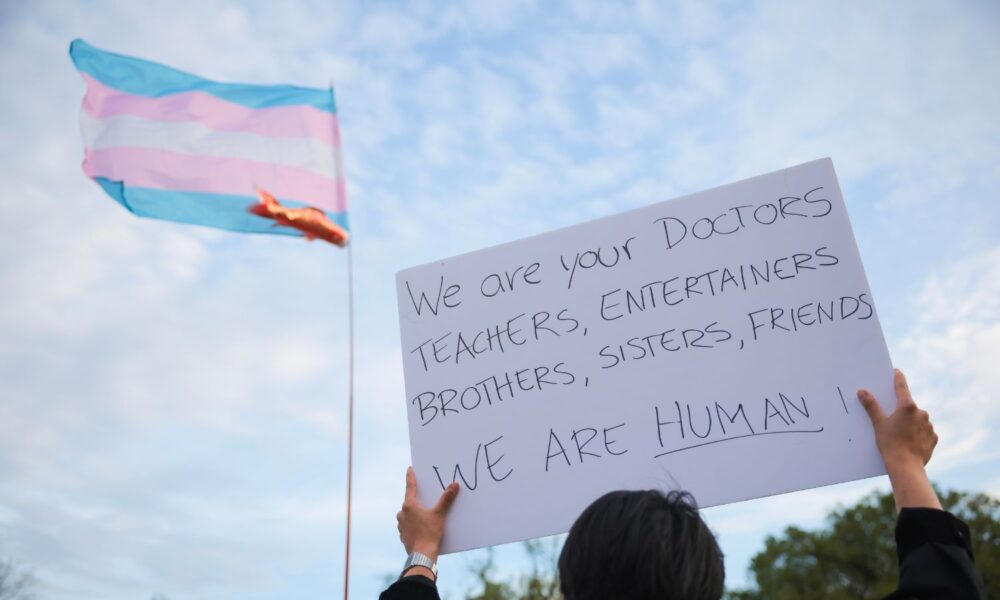WARNING: This article contains discussion of suicide.
On the first day of his second term, President Donald Trump signed an executive order targeting gender identity. In the days that followed, he would issue similar edicts limiting LGBTQ+ and gender expression in schools. With a sweep of his pen, he tried to erase transgender, nonbinary, and intersex people from existence altogether, both by ordering the removal of the words “gender” and “nonbinary” from government forms and by defunding what he labels “gender ideology.”
It should go without saying that LGBTQ+ people are our friends, neighbors, family members, and people in our community. They’re human beings with the same joys, sorrows, talents, and flaws as the rest of us. Trans and nonbinary people are not looking for special treatment—just to have the same rights as everyone else—and don’t deserve to be targeted and persecuted by this administration (here are two guides to help you know a bit more about some of the people in your community).
That we have arrived here is no surprise. Despite decades of progress toward equal rights for the LGBTQ+ community, there has been backlash against their inclusion and acceptance in recent years, including targeted condemnation by conservative politicians and some religious groups for any departure from “traditional” gender norms. The pushback on LGTBQ+ rights, spike in anti-trans rhetoric, and public debate over gender-affirming care for minors gave then-presidential candidate Donald Trump a handy wedge to divide the country during last year’s election and advance discriminatory and harmful policies from day one of his administration. It was an issue he wanted front and center in his presidential campaign, as he spent tens of millions of dollars on anti-trans ads.
President Trump’s blatant lies about children “being pushed to be transgender” by teachers and getting a “brutal operation” at school—apparently referring to gender reassignment surgery—and other inflammatory statements succeeded in stoking many parents’ fears and sowed divisions within political parties. The media seized on the issue as a “culture war,” and its intense focus on trans kids exacerbated both while contributing to a decline in the public’s overall support for trans rights.
We know President Trump is no friend of science or of providing health care to those who need it. His administration made sure to install agency heads who would fall in line with his cruel agenda and has taken steps like:
- the US Department of Health and Human Services issuing a completely bogus study reviewing “the evidence” of gender-affirming care, which my colleague Jules Barbati-Dajches covered at length in this blog.
- the US Defense Department—now known as the “Department of War” —pushing out any trans service members and prohibiting insurance coverage of gender-affirming care for service members and their families.
- the US Department of Veteran’s Affairs ending coverage of gender-affirming care.
…to name just a few.
The administration’s many anti-science decrees might explain the trans-targeting action that may cause the greatest harm to those President Trump is claiming to protect: his January 28 executive order which attempts to ban transgender care for children. Amid the backdrop of a culture war, transphobic rhetoric, and harmful public policies, it also should be no surprise this attack on children is contributing to a major public health crisis: youth suicide.
LGBTQ+ children at risk
Suicide is the second leading cause of death in kids between ages 10 and 14, and the third leading cause of death for 15- to 19 year olds. (Gun violence is number one.) At particular risk of dying by suicide: LGBTQ+ youth. Being LGBTQ+ increases the likelihood of seriously contemplating suicide (41%) compared with their heterosexual peers (13%). And within that group, trans and nonbinary kids are at an even higher risk of death by suicide than their queer, cisgender peers.
Suicidality is not intrinsic to being LGBTQ+. A factor behind the disproportionate number of gay, queer, trans, and nonbinary kids dying by suicide is the bullying and social rejection many of them experience. LGBTQ+ kids are nearly twice as likely to be bullied than kids who are heterosexual and cisgender (not gay or trans). Examples abound of kids just trying to live authentically as themselves who are subjected to bias-based bullying, are rejected by their own families, and make suicide attempts as a result.
Walk into a children’s psychiatric hospital unit and chances are most of the kids there are on the LGBTQ+ spectrum. That’s because those children—particularly those whose gender identity doesn’t conform to societal norms—are more likely to attempt suicide. One in five LGBTQ+ students reported that they attempted suicide in 2023, according to a survey by the Centers for Disease Control (CDC).
Many kids who struggle with suicidality have a disability or are neurodivergent (ADHD, diagnosed anxiety, or autism spectrum disorders) —a large percentage of whom are also LGBTQ+.
Acceptance and appropriate healthcare save kids’ lives
One potential way to help prevent these children’s deaths and lessen their psychological distress is to offer acceptance—not the harmful executive orders coming from the White House.
Respecting people’s identities, no matter how young they may be, is powerful in shaping their sense of self-worth. Some folks may find convincing the arguments that LGBTQ+ representation in school library books and materials “sexualizes” children. But pretending kids don’t know who they are and who they love isn’t protecting them. Acknowledging and accepting them isn’t sexualizing them. It saves lives and releases children from the sense of shame they feel when forced to hide who they are.
It’s simple: suicide rates for LGBTQ+ children fall when they are welcomed and supported by their communities. Another major factor influencing LGBTQ+ adolescents’ mental health is whether they have access to mental healthcare and gender-affirming care. Studies bear out that the earlier kids access this care, the better.
The National Institutes of Health (NIH), as well as dozens of medical associations across the world, all say this is true. A 2023 study found that initiation of puberty blockers or gender-affirming hormones is associated with 60% lower odds of depression and 73% lower odds of suicidality in the first 12 months of treatment.
To eliminate gender-affirming care as the Trump administration aims to do is to cut off a lifeline for trans adolescents who face a higher rate of bullying and attempted suicide, anxiety, depression, and death by suicide without it.
Culture wars and wedge issues should not shape laws
The culture war against LGBTQ+ youth—against acknowledging that science shows kids can recognize at an early age that they’re gay or trans, against the proven benefits of transgender kids’ participation in sports, and against teachers calling them by the name and pronouns they prefer—has successfully recruited people across the political spectrum with its fearmongering rhetoric and disinformation.
Of course, it’s not just a wedge issue or a culture war. It’s a human rights and public health issue, and children are at the center of it. Politicians clamoring about trans girls playing on sports teams and using girls’ bathrooms seem disinterested in surging anti-trans violence and the growing mental health crisis among trans children.
Far from following medical experts’ recommendations on gender-affirming care to address this crisis, the lawmakers are clinging to their bigoted views, totally disregarding the harm they are known to cause. Anti-trans legislation has gained momentum, with twenty-seven states, including Texas, Florida, and Ohio, outlawing transgender care for minors over the past four years—care that usually includes counseling and hormone treatment, both of which are also prescribed to non-trans youth.
New Hampshire and Arizona have banned gender-affirming surgery for minors, although most trans-identifying kids don’t have such surgery, and even prescribing puberty blockers or gender-affirming hormones to children is exceedingly rare.
Before reaching puberty, the transition kids make is most often social. That’s when someone takes non-medical and fully reversible steps to begin living and presenting publicly as their gender, according to the Human Rights Campaign (HRC). A social transition includes:
- Using a new name and pronouns
- Adopting a new hairstyle
- Wearing different clothing
- Disclosing gender identity to people in their lives
The recent Supreme Court decision allowing Tennessee to uphold a ban on gender-affirming care for minors in the state could inspire even more states to enact similar bans. At the federal level, not only did the Trump administration ban medical care for trans children, but also ordered the removal of gender “ideology” from all federally funded sex ed materials. By erasing LGBTQ+ people from official documents, teaching materials and cutting funding for scientific research about gender issues, we are taking a step backward toward forcing people to conceal their true gender or sexuality.
It’s also important to note that calling transgender people’s existence and rights an “ideology” is a misnomer that denies the scientific fact, biological reality, and lived experience of trans people that gender is more of a spectrum than a binary. Even biological sex isn’t strictly limited to male and female—those are just the most common sexes among some possibilities that depend on various physical, genetic, hormonal, and chromosomal factors.
“Such proposals to define sex into two easily determined categories are unsupported by science and oversimplify the intricate nature of human biology. It is crucial to understand that biological sex is determined by biology, not politics,” the American Association for Reproductive Medicine says.
The lessons our kids are taking from us
What drives some kids to bully and treat their LGBTQ+ peers with contempt? Based on my own observations, as a parent and a former teacher, bullies often parrot talking points circulating in the media on gender politics. Sometimes the narrative children victimize their classmates with is based on disinformation disseminated online for political gain or religious justifications. The mistreatment ranges anywhere from social exclusion to frequently telling LGBTQ+ kids to kill themselves.
What is most shameful of all is elected officials risking the health and safety of a marginalized group of children and using them as pawns in a high stakes win-at-all-costs political game.
President Trump’s actions aim to stop things that are rare or don’t happen, like “chemical and surgical mutilation,” and their “radical indoctrination” with “gender ideology,” while also conveniently distracting the public from his authoritarian power grab. But more importantly, his orders hurt trans kids—they inflict pain when kids see their right to exist debated, when they see their president encouraging others to reject them in terms that harm their mental health. His orders deny them the gender-affirming care that’s critical to their mental health: care that should be decided on by children, their guardians, and doctors, not by President Trump.
As for the President’s claim that trans kids are “a lie,” they are not a lie. Children are learning about themselves, and understanding one’s gender and sexual identities is a process that looks different for every person—including for adults. If a child isn’t actually gay or trans, that will become clear in time. No parent I know instructs their kids to be cavalier or thoughtless about their gender identity. It’s unlikely a child will take on a totally false identity and keep up an act forever—and even if they do, so what? Showing kids care and unequivocal acceptance saves lives. Period. Study after study and reams of data bear this out.
Protecting kids means standing up for all of them
In the upcoming election, I hope that candidates stand firm in their support of LGBTQ+ people. I hope they patiently explain to constituents that LGBTQ+ acceptance poses no threat to children. I hope they fight for children’s rights so they’re not bullied, denied lifesaving healthcare, and so they can see themselves represented in books in their schools, sports and across our rich, multifaceted society.
In the past few decades, we have come far to improve the acceptance and rights of LGBTQ+ people. But progress is incremental, and as we have seen this year, it can be rolled back with a pen stroke. We mustn’t allow all that progress to be lost.

